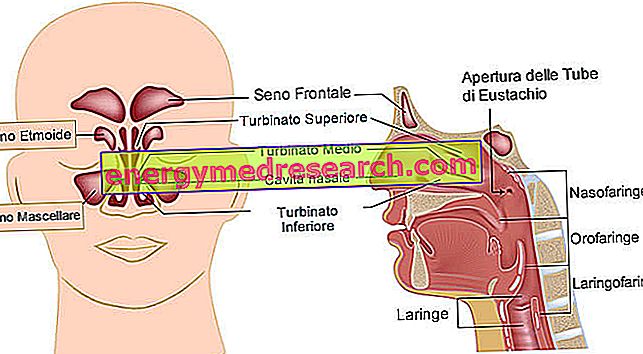Generality
The turbinates, or nasal horns, are small lateral bony projections of the nasal septum, covered by erectile-cavernous vascular tissue (more internally) and by an eyelash respiratory mucosa (more externally).
Arranged horizontally and one above the other, the turbinates are generally three for each nostril: the turbinate lying higher than all is the upper turbinate; the turbinate located in the middle is called the middle turbinate; finally, the lower turbinate of all is the lower turbinate.
The particular anatomy of the turbinates creates, inside the nasal nostrils, an extensive surface of contact between the inhaled air and the respiratory mucosa of the turbinates themselves

Turbinates play a very important role in the breathing process. In fact, they contribute to heating, purification and humidification of the air inspired by the nose and directed to the lungs.
Moreover, the turbinates also have an immunological function, as one of its coatings houses cells of the immune system.
The most important pathology that has as its object the turbinates is the so-called turbinate hypertrophy.
What are turbinates?
The turbinates, or nasal horns, are lateral bony projections of the nasal septum, located inside the two nasal cavities and covered with vascular tissue and respiratory mucosa.
Anatomy
The turbinates protrude from the bone structure that constitutes the nasal septum. The nasal septum is the vertical osteo-cartilaginous lamina, which separates the two nasal cavities and whose linearity guarantees the correct flow of air inside both nostrils.
For each nasal cavity, there are 3 turbinates, arranged horizontally, one above the other: the turbinate lying higher than all is the upper turbinate ; the turbinate located in the middle is called the middle turbinate ; finally, the lower turbinate of all is the lower turbinate .
- Upper turbinate: is an offshoot of the skull bone called an ethmoid (or ethmoid bone). Due to its particular position, it guarantees protection to the olfactory bulb.
- Medium turbinate: like the upper turbinate, it is an offshoot of the ethmoid. However, compared to the upper turbinate, it has larger dimensions.
In terms of length, it is comparable to a little finger of a human being's hand.
Most of the inhaled air passes between the middle turbinate and the inferior turbinate.
- Lower turbinate: unlike the other two turbinates, it is a bone of its own, which is articulated with the maxillary bone.
Generally, it is as long as the index finger of a human being's hand.
From the functional point of view, it probably represents the most important turbinate.
The particular anatomy of the turbinates means that the contact surface between the inhaled air and the turbinates themselves is remarkable.
The considerable contact surface between inhaled air and turbinates has a fundamental physiological role (see the chapter dedicated to functions).

HISTOLOGY OF TURBINATES
The turbinates have a double coating: an external coating, in direct contact with the air inspired in the nose, and an internal coating, below the previous one.
- The outer lining of the turbinates is a ciliated respiratory epithelium, having the ability to secrete mucus . In other words, it is a mucosa provided with eyelashes.
Similar in fact to the mucosa that covers the outer layers of the airways directed to the lungs, the ciliated respiratory epithelium of the turbinates has a thickness varying between 2 millimeters (upper turbinates) and 5 millimeters (inferior turbinates).
- The inner lining of the turbinates, underlying the respiratory mucosa, is a highly vascularized (hypervascularized) cavernous erectile tissue (similar to that of the penis).
Like all blood vessels present in the human body, even the blood vessels of the erectile-cavernous tissue of the turbinates can, following specific stimuli, dilate (swelling the turbinates) or shrink (deflating the turbinates).
CHANGES
In some individuals, there is a fourth pair of turbinates above the pair of superior turbinates: the so-called supreme turbinates . Generally, the supreme turbinates are small bony ridges, with unclear functions.
Function
The turbinates play an important role in the breathing process, contributing significantly to heating, purification and humidification of the inhaled and direct air to the lungs.
- Heating: the action of heating the air is up to the complex and wide network of blood vessels, which distinguishes the erectile-cavernous tissue forming the inner lining of the turbinates.
- Purification and humidification: the purification and humidification actions of the air belong, respectively, to the eyelashes and the respiratory mucosa, constituting the external coating of the turbinates. In fact, the eyelashes block impurities, while the respiratory mucosa produces mucus.
The efficiency in heating, purification and humidification actions is due to the large contact surface, which the turbinates make available to the inhaled air. In fact, a large contact surface prolongs the permanence of the air in the cavities that house the turbinates, guaranteeing in this way sufficient time for a correct action of heating, purification and humidification.
IMMUNOLOGICAL ROLE OF TURBINATES
Turbinates also have an immunological role .
In fact, several medical studies have shown that the respiratory epithelium of the turbinates is home to cells of the immune system .
The presence of immune cells on the respiratory epithelium guarantees an effective defense against possible bacteria, viruses and other pathogens, which could populate the air inspired by the nose.
Associated pathologies
The turbinates are the protagonists of a very known condition, which doctors call turbinate hypertrophy .
WHAT IS THE HYPERTROPHY OF TURBINES AND WHAT SYMPTOMS CAUSES?
Turbinate hypertrophy is the result of chronic and permanent swelling of the turbinate eyelid respiratory mucosa. This swelling involves a reduction in the space available for normal nasal breathing, so those suffering from turbinate hypertrophy develop symptoms such as:
- Closed nose, which induces to breathe with the mouth;
- Dry mouth;
- Leakage of serous material from the nose (rhinorrhea);
- Decrease of smell (hyposmia);
- Nasal itching;
- Tendency to snoring and sleep apnea.
- Feeling bad breathing
- Pain in the root of the nose
- sneezing
- Nose blood (epistaxis)
- Halitosis
- Nasal or metallic voice (rhinolalia)
- Headache (headache)
- Hearing reduction (hearing loss)
- Ear wadding
- Dry and irritating cough
CAUSES OF HYPERTROPHY OF TURBINES
The turbinate mucosa reacts to certain stimuli - such as changes in humidity or temperature, irritants, viral or bacterial infections, etc. - with dilation.
In the presence of healthy turbinates, the mucosa deflates and returns to assume its normal appearance as soon as the stimulus ends.
In the presence instead of an anomaly affecting the turbinates and the mechanism that regulates their dilation, the mucosa remains permanently swollen, despite the stimulus ceases.
To alter the behavior of the turbinates, in response to certain stimuli, can be conditions such as allergic rhinitis, vasomotor rhinitis, deviation of the nasal septum (deviated nasal septum) and chronic exposure to irritants (eg cigarette smoke, etc.).
Risk factors of turbinate hypertrophy:
- Viral or bacterial infections
- Family predisposition
- Air pollution
- Prolonged use of vasoconstrictor nasal sprays
COMPLICATIONS
The complications that can derive from the presence of turbinate hypertrophy consist of: chronic sinusitis, recurrent or chronic pharyngitis, roncopathy, sleep apnea syndrome with marked daytime sleepiness, nasal polyps, otitis media and dependence on the use of decongestant sprays.
DIAGNOSIS OF TURBINATE HYPERTROPHY
In general, the diagnostic procedure that establishes the presence of turbinate hypertrophy includes the physical examination, the anamnesis and a series of specific otorhinolaryngological tests, for the discovery of the causes and degree of nasal obstruction.
Among the otorhinolaryngological tests indicated in the case of turbinate hypertrophy include: rhinofibrolaringoscopy, cytological nasal examination, rhinomanometry and allergological screening.
TREATMENT OF HYPERTROPHY OF TURBINES
The first-line treatment of turbinate hypertrophy is conservative and involves the administration of different categories of drugs.
If the conservative treatment, on a pharmacological basis, fails or does not lead to an obvious improvement in the symptoms, the only solution available to patients is surgical therapy.
- Pharmacological treatment. The drugs used in case of turbinate hypertrophy include: antihistamines, antibiotics, immunosuppressants, cortisone-based nasal sprays (anti-inflammatories) and endonasal vasoconstrictors.
The choice of medicines to use depends on the causes. For example, episodes of turbinate hypertrophy due to allergic rhinitis require antihistamines and anti-inflammatories.
- Surgical therapy. There are various surgical approaches for the management of turbinate hypertrophy. The following are worth mentioning: traditional treatments, such as partial turbinectomy, lower mucotomy or submucosal emptying, new laser and radiofrequency surgery techniques.
While traditional treatments could also involve part of the turbinates, the new laser or radiofrequency techniques are minimally invasive.



